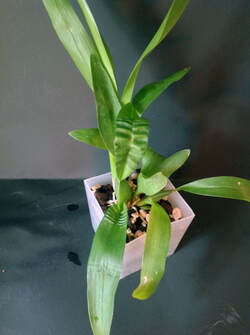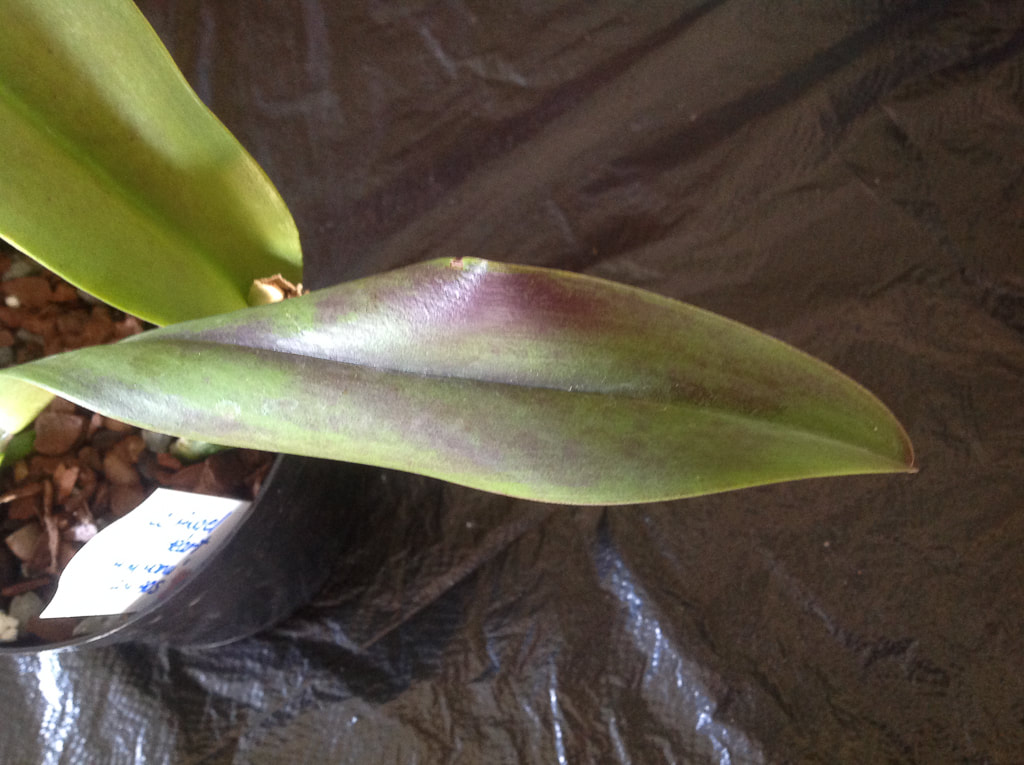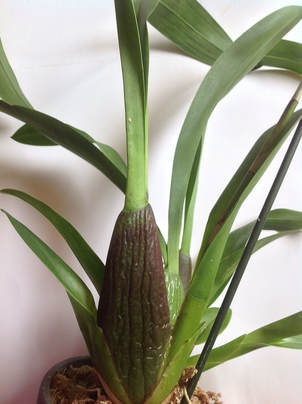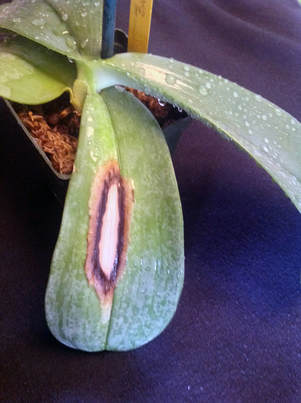The following articles came from questions I have received concerning orchid care, facts or trivia.
How Do I Get My Phalaenopsis Orchid to Bloom?
Phalaenopsis orchids truly are creatures of habit. Getting them to bloom can be as easy as putting them outside in the fall. They are cued to begin producing bud spikes after the nighttime temperatures drop to 55 F. It still amazes me how predictable this genus of orchid can be. I live in southeastern Pennsylvania and move my orchids outside in May of each year and bring them back inside in late September/early October after the nighttime temperatures have dipped into the low 50s F. Within 2 months of bringing them back inside, all of my Phalaenopsis orchids will have set bud stems. My other genera of orchids also do well outdoors; but, none of them are as dependable as the Phalaenopsis.
You don’t even have to put a Phalaenopsis outside all summer or outside at all for that matter. You just have to give it about 2 weeks where it has nighttime temperatures around 55 F. This can be in a cooler, dark location in your home, such as a garage, where you can move it at night. Just make sure it still gets normal light during the day.
You don’t even have to put a Phalaenopsis outside all summer or outside at all for that matter. You just have to give it about 2 weeks where it has nighttime temperatures around 55 F. This can be in a cooler, dark location in your home, such as a garage, where you can move it at night. Just make sure it still gets normal light during the day.
When Should I Cut Off My Phalaenopsis Bud Stem?
This is one of the most common questions I get at my orchid classes. With most genus of orchids, it’s easy to know when to get rid of the bud stem because it either dries up or falls off. With Phalaenopsis orchids, it’s not so easy, especially if it’s an orchid that is blooming for the first time for you. For example, a Phalaenopsis bud stem can:
What any given Phalaenopsis orchid bud stem will do is completely dependent upon the plant’s genetic makeup. Some Phalaenopsis orchids have been hybridized to produce a lot of blooms and to keep blooming. Bud stems from these orchids have a tendency to “rebloom” after the first set of blooms have dried up and fallen off. Other Phalaenopsis orchids will produce keikis, or new little plants, from the unused nodes on bud spikes.
My standard answer to this question is to leave a Phalaenopsis bud stem alone as long as it is green. If the bud stem turns brown or dries up, cut off the dead part. Sometimes, the top portion of the bud stem will die, but the bottom portion will stay green. Eventually, the bud stem will either completely die or begin to grow from an unused node on the green stem. When the bud stem has finished producing blooms, it will dry completely. In this case, it can be cut off close to the orchid's main stem.
- stay green and do nothing
- turn brown and dry up
- produce additional blooms from the tip
- produce side shoots at unused nodes with additional blooms
- produce a keiki at an unused node
What any given Phalaenopsis orchid bud stem will do is completely dependent upon the plant’s genetic makeup. Some Phalaenopsis orchids have been hybridized to produce a lot of blooms and to keep blooming. Bud stems from these orchids have a tendency to “rebloom” after the first set of blooms have dried up and fallen off. Other Phalaenopsis orchids will produce keikis, or new little plants, from the unused nodes on bud spikes.
My standard answer to this question is to leave a Phalaenopsis bud stem alone as long as it is green. If the bud stem turns brown or dries up, cut off the dead part. Sometimes, the top portion of the bud stem will die, but the bottom portion will stay green. Eventually, the bud stem will either completely die or begin to grow from an unused node on the green stem. When the bud stem has finished producing blooms, it will dry completely. In this case, it can be cut off close to the orchid's main stem.
How Are Orchids Propagated?
Part I - Vegetative Propagation
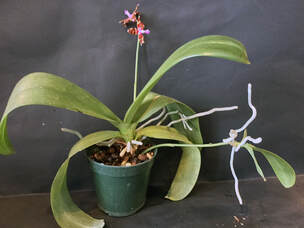
Orchids can be propagated by three distinct methods: Vegetative Propagation, Meristem Cloning, and Pollination. I’ve listed these in order of difficulty and will address each of them separately. Vegetative Propagation is by far the easiest way to propagate your orchid as the orchid does all the work. You just have to buy an genus and species that is prone to producing keikis.
Vegetative propagation is a form of asexual reproduction, which means that there is only one parent plant involved. The offspring, called a keiki in the case of orchids, will be identical to the parent. Keikis will form at an unused node along the stem of an orchid or an older bud stem. A “node” as a place where meristem cells exist. These cells can develop into a leaf, a bud spike or a keiki. The photo to the left is my Phalaenopsis (Phal) bastianii which produced a keiki at the end of an old bud stem.
I’ve had keikis develop at the base of a Phalaenopsis orchid, at the end of an old bud stem on a Phalaenopsis orchid, and along the stem of a bamboo-type Dendrobium orchid. Don’t confuse keikis with the sympodial growth habits of many orchid genus. Orchids that are growing sympodially will produce new growth shoots from the base of the plant; however, these shoots are part of the original plant and could not survive on their own. Keikis will produce their own root systems and can eventually be detached from the parent plant and will survive on their own.
Unfortunately, whether or not an orchid will produce keikis is mostly determined by its genetics. Phal bastianii is one of the orchid species that will readily produce keikis under the right conditions. Some varieties of the bamboo-like Dendrobium orchids are prone to making keikis when a stem loses its leaves and begins to die off. If you are interested in raising orchids that will produce keikis, you need to research the plants you’re considering buying.
Vegetative propagation is a form of asexual reproduction, which means that there is only one parent plant involved. The offspring, called a keiki in the case of orchids, will be identical to the parent. Keikis will form at an unused node along the stem of an orchid or an older bud stem. A “node” as a place where meristem cells exist. These cells can develop into a leaf, a bud spike or a keiki. The photo to the left is my Phalaenopsis (Phal) bastianii which produced a keiki at the end of an old bud stem.
I’ve had keikis develop at the base of a Phalaenopsis orchid, at the end of an old bud stem on a Phalaenopsis orchid, and along the stem of a bamboo-type Dendrobium orchid. Don’t confuse keikis with the sympodial growth habits of many orchid genus. Orchids that are growing sympodially will produce new growth shoots from the base of the plant; however, these shoots are part of the original plant and could not survive on their own. Keikis will produce their own root systems and can eventually be detached from the parent plant and will survive on their own.
Unfortunately, whether or not an orchid will produce keikis is mostly determined by its genetics. Phal bastianii is one of the orchid species that will readily produce keikis under the right conditions. Some varieties of the bamboo-like Dendrobium orchids are prone to making keikis when a stem loses its leaves and begins to die off. If you are interested in raising orchids that will produce keikis, you need to research the plants you’re considering buying.
How Are Orchids Propagated?
Part II - Meristem Cloning
Meristem cloning, or tissue culture, is by no means “easy” to do; however, it is still “easier” than fertilizing an orchid to produce seeds. The ability to clone orchids is one of the factors that drives the cost of some genera, such as Phalaenopsis, and makes these orchids so plentiful.
Tissue culture in orchids uses meristem cells. Think of these as stem cells for plants. These are undifferentiated plant cells, which means they can develop into anything the plant needs. They are found in areas of active growth, such as leaf or root tips, nodes along the stem in monopodial plants or the rhizome in sympodial plants, or nodes along a bud stem. Simply put, under sterile conditions in a laboratory, these meristem cells are harvested and allowed to develop into tiny plants on a nutrient agar. Like vegetative propagation, meristem cloning produces plants with one parent, so all of the off-spring will be identical (ignoring the occasional mutation that may occur).
The main advantage of meristem cloning is that hundreds of copies of one plant can be made from a very small amount of meristem cells. The cells are allowed to grow, then divided and allowed to grow again. This process is repeated over and over. Also, you know what you’re getting because you can see what the parent plant looks like. The main disadvantage is that meristem cloning must be done in a sterile laboratory setting. Also, most orchids need to be 3 to 5 years old before they will bloom; so, someone is caring for these little orchids for years before you buy them.
For the ambitious orchid enthusiast, some laboratories now sell “meristem cloning kits” with step-by-step instructions on how to clone your orchid. Other laboratories will sell you flasks with 50 or 100 tiny little orchid plants in them. These orchids may only be a few months old, but it’s a cheap way to buy a lot of orchids if you have the time and space to grow them into blooming sized plants.
Tissue culture in orchids uses meristem cells. Think of these as stem cells for plants. These are undifferentiated plant cells, which means they can develop into anything the plant needs. They are found in areas of active growth, such as leaf or root tips, nodes along the stem in monopodial plants or the rhizome in sympodial plants, or nodes along a bud stem. Simply put, under sterile conditions in a laboratory, these meristem cells are harvested and allowed to develop into tiny plants on a nutrient agar. Like vegetative propagation, meristem cloning produces plants with one parent, so all of the off-spring will be identical (ignoring the occasional mutation that may occur).
The main advantage of meristem cloning is that hundreds of copies of one plant can be made from a very small amount of meristem cells. The cells are allowed to grow, then divided and allowed to grow again. This process is repeated over and over. Also, you know what you’re getting because you can see what the parent plant looks like. The main disadvantage is that meristem cloning must be done in a sterile laboratory setting. Also, most orchids need to be 3 to 5 years old before they will bloom; so, someone is caring for these little orchids for years before you buy them.
For the ambitious orchid enthusiast, some laboratories now sell “meristem cloning kits” with step-by-step instructions on how to clone your orchid. Other laboratories will sell you flasks with 50 or 100 tiny little orchid plants in them. These orchids may only be a few months old, but it’s a cheap way to buy a lot of orchids if you have the time and space to grow them into blooming sized plants.
How Are Orchids Propagated?
Part III - Pollination
The final topic of orchid propagation I’m going to cover is pollination. This is, by far, the most tedious, time-consuming method that also requires a sterile laboratory setting. About 5 years ago, I decided to expand my orchid knowledge and try my hand at pollination. I contacted a business acquaintance of mine at the Smithsonian Institute and told him my plans. His only comment to me was, “Why????” After several attempts, I understood his comment.
The whole process from fertilization to a blooming offspring orchid can take 5 years or more. Also, unless you are reproducing a known cross, there are no guarantees what the offspring will look like after you wait the 5 years. The process can be broken down into 3 parts:
You can save some time commitment by sending your seed pod off to a laboratory to sow and flask. You receive back the flask orchids, usually in 2 – 3 years. In general, fertilizing orchids is only for the very serious collector, or for those who are trying to create the elusive “blue” orchid.
The whole process from fertilization to a blooming offspring orchid can take 5 years or more. Also, unless you are reproducing a known cross, there are no guarantees what the offspring will look like after you wait the 5 years. The process can be broken down into 3 parts:
- Fertilization – This is where the pollinia from one orchid are moved to the stigma of another orchid. The receiving orchid is known as the mother plant and will develop the seed pod. It can take 6 months or longer for a seed pod to ripen and then you may not have viable seeds. Not all crosses will produce viable seeds.
- Seed Sowing – Orchids produce “naked seeds” which means they don’t have an endosperm. The orchid seeds are dispersed into a sterile nutrient solution, usually in flasks. This is known as flasking. The seedlings will need to be moved periodically from one flask to another. It can take up to 6 months for orchid seeds to germinate and a minimum of another 1 to 1 ½ years before they are big enough to survive outside the flask.
- Seedlings – Most seedlings will need another year or more to become old enough to produce a bloom.
You can save some time commitment by sending your seed pod off to a laboratory to sow and flask. You receive back the flask orchids, usually in 2 – 3 years. In general, fertilizing orchids is only for the very serious collector, or for those who are trying to create the elusive “blue” orchid.
Why Doesn't My Orchid Have a Scent?
Unlike roses, lilacs, or other fragrant flowers that we love, not all orchids produce a scent. Orchidaceae is unique in that each orchid species evolved to attract a specific pollinator. This means that the color, shape or scent of an orchid bloom is very closely tied to the needs or desires of their specific pollinator. If the pollinator can be attracted without a scent, the orchid won’t waste its energy producing one. Orchids are energy-conserving, masters of deception and can even look like an oil-producing flower, without actually having the nectar reward for its pollinator.
Many of the orchids that are trying to attract a daytime pollinator rely on bloom color and shape. For example, orchids that reply on hummingbirds are bright red or orange and have tubular lips. While there are some daytime pollinating orchids that have a scent, many of the scented orchids produce their scent at night. These are the orchids that are trying to attract nighttime pollinators, likes moths. The scent brings the moth to the flower. In many cases, the colors of these blooms are white or green and less showy as the orchid is relying on scent. Again, why waste the energy to produce a showy flower that its pollinator won’t see at night?
So, in answer to this question, there are two reasons why you don’t notice a scent with your orchid. First, your orchid may not produce a scent; and, second, you may need to be awake at 2:00am to notice the scent of your orchid. I have a beautiful, light green colored Cattleya hybrid that produces an absolutely heavenly scent at night. Luckily my dining room is small, so the scent remains when I get up in the morning.
Another thing to consider is that you may not want to be around some orchids when they produce their scent. The Bulbophyllum orchid has been described as having the aroma of “a thousand dead elephants rotting in the sun”. It’s trying to attract female carrion flies.
Many of the orchids that are trying to attract a daytime pollinator rely on bloom color and shape. For example, orchids that reply on hummingbirds are bright red or orange and have tubular lips. While there are some daytime pollinating orchids that have a scent, many of the scented orchids produce their scent at night. These are the orchids that are trying to attract nighttime pollinators, likes moths. The scent brings the moth to the flower. In many cases, the colors of these blooms are white or green and less showy as the orchid is relying on scent. Again, why waste the energy to produce a showy flower that its pollinator won’t see at night?
So, in answer to this question, there are two reasons why you don’t notice a scent with your orchid. First, your orchid may not produce a scent; and, second, you may need to be awake at 2:00am to notice the scent of your orchid. I have a beautiful, light green colored Cattleya hybrid that produces an absolutely heavenly scent at night. Luckily my dining room is small, so the scent remains when I get up in the morning.
Another thing to consider is that you may not want to be around some orchids when they produce their scent. The Bulbophyllum orchid has been described as having the aroma of “a thousand dead elephants rotting in the sun”. It’s trying to attract female carrion flies.
Why Did the Name of My Orchid Change?
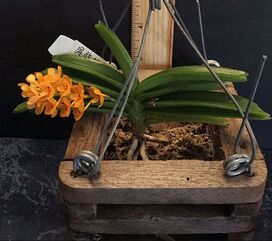
When Carl Linnaeus created the modern taxonomy system in the 1700s, he classified organisms based on shared characteristics. In Orchidaceae, these shared characteristics were primarily the shape and color of the blooms. However, with the invention of gene sequencing, these classifications have come into question.
Sequencing the entire genome of each orchid species would be far too time consuming and tedious. So, scientists pick 4 or 5 genes that would be common to the different genera. Then they look for mutations at certain locations in these genes. The more mutations two orchid species have in common, the more closely related they are. This process has led to some genus being split apart, and some genus being combined.
For example, the Vanda miniata in the photo above was originally classified as Ascocentrum miniatum until genetic sequencing showed it was actually more related to the Vanda genus.
Sequencing the entire genome of each orchid species would be far too time consuming and tedious. So, scientists pick 4 or 5 genes that would be common to the different genera. Then they look for mutations at certain locations in these genes. The more mutations two orchid species have in common, the more closely related they are. This process has led to some genus being split apart, and some genus being combined.
For example, the Vanda miniata in the photo above was originally classified as Ascocentrum miniatum until genetic sequencing showed it was actually more related to the Vanda genus.
Where Should I Buy My Orchids?
This is an excellent question and the answer depends upon your reason for buying the orchid. Orchids are a perfect example of “you get what you pay for”. One thing to keep in mind when you purchase an orchid is that most orchids are 3 to 5 years old before they bloom. This means that someone has been taking care of that plant for 3 to 5 years before you buy it. The better that care was, the healthier and more vigorous the plant will be.
Some people buy a blooming orchid plant as a disposable commodity, much the same as they would buy a bouquet of cut flowers. If this is the case, then it’s fine to go to a discount store or home store and buy the cheapest orchid you can find. These are usually Phalaenopsis which will bloom for 3 or more months.
If, however, you are buying an orchid that you would like to raise and get to bloom again, you want to buy this plant from a reputable orchid grower. These people have taken the best possible care of the orchid for its first couple years of life giving you a strong, healthy plant. Other advantages of buying from an orchid grower is they will have a much wider selection of orchids for you to choose from; and, they will be able to help you with the care each orchid requires.
Attending an orchid show is an excellent way to find reputable orchid growers and a wide selection of orchids for sale.
Some people buy a blooming orchid plant as a disposable commodity, much the same as they would buy a bouquet of cut flowers. If this is the case, then it’s fine to go to a discount store or home store and buy the cheapest orchid you can find. These are usually Phalaenopsis which will bloom for 3 or more months.
If, however, you are buying an orchid that you would like to raise and get to bloom again, you want to buy this plant from a reputable orchid grower. These people have taken the best possible care of the orchid for its first couple years of life giving you a strong, healthy plant. Other advantages of buying from an orchid grower is they will have a much wider selection of orchids for you to choose from; and, they will be able to help you with the care each orchid requires.
Attending an orchid show is an excellent way to find reputable orchid growers and a wide selection of orchids for sale.
Are Orchids Delicate and Fragile?
I think orchids got the reputation as being the delicate prima donnas of the flower world for two reasons: (1) anything that exotic and beautiful has to be fragile; and (2) they are easy to kill if you don’t know how to take care of them.
The truth is that orchids are survivors. As mentioned on my Home Page, recent genetic sequencing has shown that orchids probably arose in the Late Cretaceous period, approximately 112 million years ago. This makes these plants very adaptable and hardy from an evolutionary standpoint. So, don’t look at the beautiful, frilly flowers and think fragile. Consider the fact that the vanilla extract used in cooking is produced from an orchid genus that came into being about 80 million years ago and is still alive today.
The key to raising orchids is learning how they grow in nature to understand how to care for them at home. Once you understand this, orchids are actually very easy to grow.
The truth is that orchids are survivors. As mentioned on my Home Page, recent genetic sequencing has shown that orchids probably arose in the Late Cretaceous period, approximately 112 million years ago. This makes these plants very adaptable and hardy from an evolutionary standpoint. So, don’t look at the beautiful, frilly flowers and think fragile. Consider the fact that the vanilla extract used in cooking is produced from an orchid genus that came into being about 80 million years ago and is still alive today.
The key to raising orchids is learning how they grow in nature to understand how to care for them at home. Once you understand this, orchids are actually very easy to grow.
What is Crown Rot?
This is a question that I get ask at every class or presentation I give. It usually comes up right after I explain the best way to water an orchid which is to place it in your sink and spray it with the hose. Inevitably, I will be asked, ‘Won’t that method of watering leave water in the crown of the orchid which will lead to crown rot?”
This is an excellent question which has a somewhat complicated answer. First, let me explain what the crown is. The “crown” of a plant is the part of the plant that grows above the soil, i.e. leaves and stems. Crown rot is a fungal disease that affects the crown of a plant. The fungus that causes this disease is present in most soils and only becomes a problem under prolonged moist conditions. Crown rot is almost always fatal to orchids. The fungus move up the stem from the soil and destroys the stem and nodes that produce new leaves. The only chance to save your orchid once crown rot starts is to catch it early, use a good fungicide, and repot your orchid in new media.
The key to protecting your orchids from crown rot is to prevent it. This is done by preventing prolonged moist conditions in your orchid's media. I have never had an instance of crown rot with any of my orchids, even though I use the sprayer hose to water them. Here are some tips:
This is an excellent question which has a somewhat complicated answer. First, let me explain what the crown is. The “crown” of a plant is the part of the plant that grows above the soil, i.e. leaves and stems. Crown rot is a fungal disease that affects the crown of a plant. The fungus that causes this disease is present in most soils and only becomes a problem under prolonged moist conditions. Crown rot is almost always fatal to orchids. The fungus move up the stem from the soil and destroys the stem and nodes that produce new leaves. The only chance to save your orchid once crown rot starts is to catch it early, use a good fungicide, and repot your orchid in new media.
The key to protecting your orchids from crown rot is to prevent it. This is done by preventing prolonged moist conditions in your orchid's media. I have never had an instance of crown rot with any of my orchids, even though I use the sprayer hose to water them. Here are some tips:
- Make sure your orchid has good air flow around it, no drafts though. This prevents the humid conditions that can lead to fungal growth.
- Use a good orchid media that drains well. This keeps water from staying in the media too long.
- Repot your orchid when the media appears to be breaking down. This gets rid of any rotted plant matter, which can provide food for the fungus.
- Always water your orchids early in the day. Any water that sits in the crown will run out, evaporate, or be absorbed while the orchid is still photosynthesizing in the daylight. Problems occurs when water sits in the crown overnight.
Why Are My Orchid's Leaves Pleated?

Some orchid genera have vertically pleated leaves, such as the Zygonisia Murasskikomachi 'Cool Room' plant shown at the left. These leaves are one of the things that makes this orchid unique and beautiful. If, however, you are growing a genus that does not normally have pleated leaves, such as the Oncidium shown above, horizontal pleating across the leaf indicates a lack of water.
Orchids use the process of respiration to burn their stored carbohydrates and produce new plant material. The respiration process requires water. If the plant is not getting enough water while it is trying to make new plant material, such as leaves, then the respiration process is interrupted and doesn’t proceed smoothly. This leads to pleating in the orchid’s new leaf growth. The leaves will never “unpleat” and, while they may stretch out, they will always have a wrinkled appearance.
Orchids use the process of respiration to burn their stored carbohydrates and produce new plant material. The respiration process requires water. If the plant is not getting enough water while it is trying to make new plant material, such as leaves, then the respiration process is interrupted and doesn’t proceed smoothly. This leads to pleating in the orchid’s new leaf growth. The leaves will never “unpleat” and, while they may stretch out, they will always have a wrinkled appearance.
How Can I Get My Orchid to Bloom?
In the latitude that I live at, fall is the time of the year that cues most orchids to end their growth phase and enter their blooming phase. This occurs because of the shorter daylight hours and the cooler nighttime temperatures. If you had your orchids outdoors for the summer or in a greenhouse, they will naturally see these cues as fall progresses. If your orchids are indoors, this is when you want to move your orchids to a windowsill, if they are not already there. Sitting on a windowsill or near a window, the orchid will notice the cooler nighttime temperatures. Also, try to get it in a room where it will see the longer darkness, i.e. don’t put it in a room that has a light on all night or is in front of street light that’s on all night.
Most orchids can tolerate nighttime temperatures down to 55 degrees F. If you’ve put your orchids outside for the summer, keep them there until the nighttime temperatures get down to 55 F. If you have your orchids indoors and can't get them near a window, another option is to move your orchids at night to a dark, cooler location in your house, such as a garage, as long as it doesn’t get colder than 55 F.
Phalaenopsis orchids tend to put out bud stems pretty quickly, so you should start seeing them appear by mid- to late-October. Oncidiums, Cattleyas and Dendrobiums can take longer since these orchids have sympodial growth habits. The bud stems on these orchids will come from the most recent shoot growth. Once you see the start of bud stems, be patient. Bud stem and bloom development can take 6 to 8 weeks or longer in some genera. You may notice that your orchid dries out faster during bud and bloom development. This is because the process of respiration, which orchids use to produce new plant material, requires water.
Most orchids can tolerate nighttime temperatures down to 55 degrees F. If you’ve put your orchids outside for the summer, keep them there until the nighttime temperatures get down to 55 F. If you have your orchids indoors and can't get them near a window, another option is to move your orchids at night to a dark, cooler location in your house, such as a garage, as long as it doesn’t get colder than 55 F.
Phalaenopsis orchids tend to put out bud stems pretty quickly, so you should start seeing them appear by mid- to late-October. Oncidiums, Cattleyas and Dendrobiums can take longer since these orchids have sympodial growth habits. The bud stems on these orchids will come from the most recent shoot growth. Once you see the start of bud stems, be patient. Bud stem and bloom development can take 6 to 8 weeks or longer in some genera. You may notice that your orchid dries out faster during bud and bloom development. This is because the process of respiration, which orchids use to produce new plant material, requires water.
What is a Native Orchid?
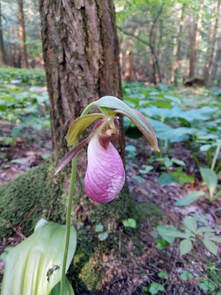
When most people think of orchids, they think of steamy jungles and tropical climates. You may be surprised to learn that there are orchids which are native to every ecosystem on Earth, except those that are permanently frozen or permanently dry. Orchids are classified as perennial herbs, which means they will grow for more than one year and lack a woody structure. In temperate or colder climates, native orchids will die back in the fall, like any other perennial plant, stay dormant underground for the winter and reappear in the spring. These types of orchids are known as hardy orchids because they can survive the winter outdoors.
The photo on the left is a Cypripedium acaule which is native to the eastern third of the United States. This photo was taken during a hike near Ithaca, New York. Native orchids are hardy orchids that are indigenous to the area they are growing in.
The photo on the left is a Cypripedium acaule which is native to the eastern third of the United States. This photo was taken during a hike near Ithaca, New York. Native orchids are hardy orchids that are indigenous to the area they are growing in.
What's the Difference Between a Native Orchid and a Hardy Orchid?
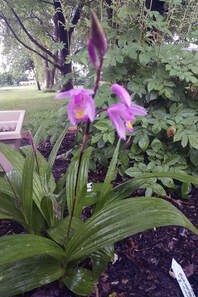
We often only think of the tropical orchids when we think of orchids. But, in reality, every continent, except Antarctica, has native orchids. In the temperate or colder climates, the native orchids will be terrestrial orchids that go dormant underground over the colder, winter months.
By definition, hardy orchids are those that are winter hardy and go dormant over the colder months. Native orchids are hardy orchids that are indigenous to the area where they are growing. The Cypripedium (Cyp) acaule is a hardy orchid that is native to the eastern third of the United States. See its picture in the article directly above this, "What is a Native Orchid?". On the other hand, my Bletilla yokohama 'Kate' orchid (shown to the left), often called a Chinese ground orchid, is a hardy orchid that is native to China, Taiwan, and Japan. It can be grown in Pennsylvania because the climate is similar. My state, Pennsylvania, is home to almost 50 different species of native orchids. The most well known is the Cyp acaule, or Pink Lady's Slipper, which likes to grow in an open woodland environment.
I should mention that it is never a good idea to dig up native orchids to bring back to your own garden. The health of a native orchid is very closely tied to the conditions it is growing in, including soil pH, soil composition and fungal species, among other things. In most cases, removing a native orchid will lead to its death. The best option is to try to buy a nursery grown specimen, which will be far more tolerant of transplanting.
By definition, hardy orchids are those that are winter hardy and go dormant over the colder months. Native orchids are hardy orchids that are indigenous to the area where they are growing. The Cypripedium (Cyp) acaule is a hardy orchid that is native to the eastern third of the United States. See its picture in the article directly above this, "What is a Native Orchid?". On the other hand, my Bletilla yokohama 'Kate' orchid (shown to the left), often called a Chinese ground orchid, is a hardy orchid that is native to China, Taiwan, and Japan. It can be grown in Pennsylvania because the climate is similar. My state, Pennsylvania, is home to almost 50 different species of native orchids. The most well known is the Cyp acaule, or Pink Lady's Slipper, which likes to grow in an open woodland environment.
I should mention that it is never a good idea to dig up native orchids to bring back to your own garden. The health of a native orchid is very closely tied to the conditions it is growing in, including soil pH, soil composition and fungal species, among other things. In most cases, removing a native orchid will lead to its death. The best option is to try to buy a nursery grown specimen, which will be far more tolerant of transplanting.
What is Scale?
Scale is, appropriately, caused by scale insects which are in the Arthropoda Phylum and Hemiptera Order. There are almost 8,000 different species of scale insects, but only about 2 dozen that infect orchids. These insects have three different life stages: egg, larva, and adult.
Let’s start with the larva or nymph stage, sometimes called “crawlers”, because this is when these insects are mobile and most susceptible to being killed. This also when the insects can jump from one orchid to another, so it is always important to isolate any orchids you think may have scale. These larvae are tiny, yellow to pink colored insects that are very difficult to see with the naked eye. The larva will crawl onto the orchid until it finds a good place to attach and feed, which can be anywhere on the orchid including the roots and rhizome. The females will then produce a protective coating that can expand as she produces eggs. This coating looks like small shells or scales on a fish, which is where the insect gets its name from. Groupings of males can actually have a cottony appearance. Because of this protective coating, the eggs and adult insects are difficult to kill.
Scale insects can cycle through one generation in 2 to 4 weeks depending upon the growth conditions. Generations of different insects can also overlap, making it very difficult to get rid of a scale infestation. There are three approaches to combating scale:
Let’s start with the larva or nymph stage, sometimes called “crawlers”, because this is when these insects are mobile and most susceptible to being killed. This also when the insects can jump from one orchid to another, so it is always important to isolate any orchids you think may have scale. These larvae are tiny, yellow to pink colored insects that are very difficult to see with the naked eye. The larva will crawl onto the orchid until it finds a good place to attach and feed, which can be anywhere on the orchid including the roots and rhizome. The females will then produce a protective coating that can expand as she produces eggs. This coating looks like small shells or scales on a fish, which is where the insect gets its name from. Groupings of males can actually have a cottony appearance. Because of this protective coating, the eggs and adult insects are difficult to kill.
Scale insects can cycle through one generation in 2 to 4 weeks depending upon the growth conditions. Generations of different insects can also overlap, making it very difficult to get rid of a scale infestation. There are three approaches to combating scale:
- Manually removing the scales when they appear. This is the safest for the orchid, but also the most labor-intensive. Most scale can be scraped off with a fingernail. The problem is that missing one female with eggs perpetuates the infection; and, it is very easy to miss one since they can attach to the roots and rhizomes. This process has to be repeated every week until no more scale appears.
- The second approach uses common household chemicals such as rubbing alcohol and dish detergent. The orchid is wiped down using a Q-tip or small cloth. However, these chemicals will only kill the crawlers, so the process has to be repeated every week until no more scale appears.
- The third approach is to buy a commercial insecticide. The orchid still has to be treated every 7 – 10 days for several months to remove the entire infestation. Even these chemicals will not kill the eggs or adults inside their scale coatings.
How Do I Grow Hardy Orchids?
In botanical terms, a “hardy” plant is one that can survive outside during winter conditions. Therefore, the term “hardy orchid” is relative to the area in which you live and the type of winter conditions it would encounter there. Vanda orchids would be hardy orchids in southern Florida, but not in Pennsylvania where I live. Luckily, orchids are native to every continent, except Antarctica, so just about everyone can find an orchid that is hardy for their area.
If you are interested in growing hardy orchids, the first thing I would suggest is to find a plant hardiness zone map for your area. If you live in the United States, you can go to the USDA Plant Hardiness Zone Map, http://planthardiness.ars.usda.gov/PHZMWeb/. This tells you the “average annual extreme minimum temperatures” for your area. Make sure any orchid you would like to plant as a perennial outdoors is hardy in your growing zone. Another temperature consideration is to make sure that the orchid can also tolerate any extreme heat that may occur in your area in the summer months.
The second suggestion for growing hardy orchids as perennial plants outdoors is to make sure you prepare their growing area properly. Many of these types of orchids need a loamy, well-drained soil. When I created the growing area for my Bletillas and Cypripediums, I dug out a 3’ by 3’ area about a foot deep. Then, I mixed equal parts of soil, peat, and sand and put that back in the hole. Any hardy orchid you buy should come with detailed planting instructions which will include the type of soil it will need.
Finally, make sure you are giving your hardy orchid the correct amount of sunlight. Both Bletillas and Cypripediums prefer a shadier location, with some dappled sunlight. I planted mine at the edge of a row of deciduous maple trees. In the early spring, this area gets direct sunlight which warms the soil for the orchids. By the time the orchids have begun to grow, leaves are appearing on the trees which shade the mature plants.
If you are interested in growing hardy orchids, the first thing I would suggest is to find a plant hardiness zone map for your area. If you live in the United States, you can go to the USDA Plant Hardiness Zone Map, http://planthardiness.ars.usda.gov/PHZMWeb/. This tells you the “average annual extreme minimum temperatures” for your area. Make sure any orchid you would like to plant as a perennial outdoors is hardy in your growing zone. Another temperature consideration is to make sure that the orchid can also tolerate any extreme heat that may occur in your area in the summer months.
The second suggestion for growing hardy orchids as perennial plants outdoors is to make sure you prepare their growing area properly. Many of these types of orchids need a loamy, well-drained soil. When I created the growing area for my Bletillas and Cypripediums, I dug out a 3’ by 3’ area about a foot deep. Then, I mixed equal parts of soil, peat, and sand and put that back in the hole. Any hardy orchid you buy should come with detailed planting instructions which will include the type of soil it will need.
Finally, make sure you are giving your hardy orchid the correct amount of sunlight. Both Bletillas and Cypripediums prefer a shadier location, with some dappled sunlight. I planted mine at the edge of a row of deciduous maple trees. In the early spring, this area gets direct sunlight which warms the soil for the orchids. By the time the orchids have begun to grow, leaves are appearing on the trees which shade the mature plants.
What is a Miniature Orchid?
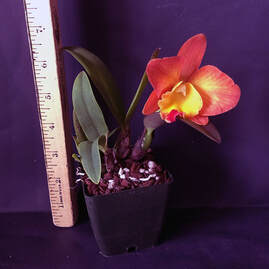
Miniature orchids have become very popular recently. When I spoke at the American Orchid Society’s (AOS) Spring Members Meeting in Homestead, Florida in 2018, I had a chance to walk around the Redland International Orchid Festival. Many of the vendors there were showcasing their miniature orchid genera; and, just about all of them had sold their supplies out by the end of the first day. I bought a Vanda miniata (shown in the article "Why Did the Name of My Orchid Change?" and the Sophrolailiocattleya (SLC) Angel's Fantasy show at the left.
The main reason I bought the miniatures was because they are irresistibly adorable! A secondary reason, however, for buying the SLC Angel's Fantasy was because the miniature is a little easier to grow and fits quite nicely on my windowsill. I love Cattleyas, but don’t have the space or correct growing conditions for them.
One question that I often get ask on miniatures is whether or not they are engineered to be small. The answer to that is “Sometimes”. Some of the miniature orchids, such as the Vanda miniata, are naturally a petite size. Other miniature orchids, such as the SLC Angel's Fantasy, were hybridized to produce a small plant and disproportionately large bloom.
As a general rule, miniature orchids will require a little more attention than normal sized orchids for several reasons. First, their small size does not allow for a lot of nutrient and water storage so they will need to be watered and fed more frequently. Second, they come in tiny little pots which allows the media to dry out faster. Third, their roots are smaller and thinner, making them more delicate. Once you adjust your care for these differences, miniature orchids can be great additions to your collection.
The main reason I bought the miniatures was because they are irresistibly adorable! A secondary reason, however, for buying the SLC Angel's Fantasy was because the miniature is a little easier to grow and fits quite nicely on my windowsill. I love Cattleyas, but don’t have the space or correct growing conditions for them.
One question that I often get ask on miniatures is whether or not they are engineered to be small. The answer to that is “Sometimes”. Some of the miniature orchids, such as the Vanda miniata, are naturally a petite size. Other miniature orchids, such as the SLC Angel's Fantasy, were hybridized to produce a small plant and disproportionately large bloom.
As a general rule, miniature orchids will require a little more attention than normal sized orchids for several reasons. First, their small size does not allow for a lot of nutrient and water storage so they will need to be watered and fed more frequently. Second, they come in tiny little pots which allows the media to dry out faster. Third, their roots are smaller and thinner, making them more delicate. Once you adjust your care for these differences, miniature orchids can be great additions to your collection.
What Type of Media Should I Use for My Orchid?
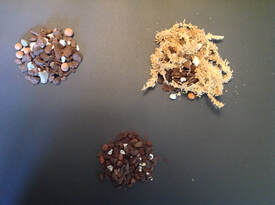
Orchids are planted in media, which is a mixture of organic and inorganic pieces. Examples of organic media pieces are sphagnum moss, tree bark, and coconut husk. In general, organic media provides for water retention; however, it will break down faster. Examples of inorganic media pieces are perlite, gravel, and clay. Inorganic media pieces do not break down as fast and provide air spaces around the orchid's root.
The pieces of material in orchid media also come in different sizes. Larger pieces will allow for less water retention and more air circulating around the orchid’s roots. Conversely, smaller pieces allow for more water retention and less air.
A good orchid media is developed for a specific orchid genus. Epiphytic and lithophytic orchids normally have their roots in the air and, to varying degrees, need the media to dry out between waterings. Terrestrial orchids prefer a media that will stay moister around their roots. The right type of orchid media can be made to meet these requirements by using different components and piece sizes.
If possible, try to buy an orchid media that was developed for your specific orchid genus. There are no "industry standards" for orchid media, so you may find mixtures with different components. This is fine as long as you are using the right mixture for your orchid genus.
The pieces of material in orchid media also come in different sizes. Larger pieces will allow for less water retention and more air circulating around the orchid’s roots. Conversely, smaller pieces allow for more water retention and less air.
A good orchid media is developed for a specific orchid genus. Epiphytic and lithophytic orchids normally have their roots in the air and, to varying degrees, need the media to dry out between waterings. Terrestrial orchids prefer a media that will stay moister around their roots. The right type of orchid media can be made to meet these requirements by using different components and piece sizes.
If possible, try to buy an orchid media that was developed for your specific orchid genus. There are no "industry standards" for orchid media, so you may find mixtures with different components. This is fine as long as you are using the right mixture for your orchid genus.
Should I Move My Orchids Outside for the Summer?
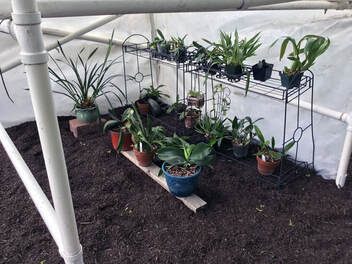
This is a question that comes up frequently in the orchid classes I teach. Having a greenhouse or sheltered patio outside to put your orchids in makes this decision a lot easier. Without either of these, you would have to create a sheltered location for your orchids. It can be as simple as the one I created which used PVC piping and plastic sheeting. The shelter is located under a large Maple tree for shade and is open on two sides to allow for air flow. The sheeting protects the orchids from wind damage.
The obvious advantage of growing orchids outside in the summer is that you are giving them conditions closer to what they would encounter in nature, which should promote better growth and blooming. This is especially true if you air condition your house. However, this advantage must be weighed against the following disadvantages:
- You can’t control the conditions outside. You could have a prolonged dry spell that would require frequent watering, prolonged heat wave that may require moving them back indoors, or prolonged rain that can lead to root or crown rot.
- Storms or high winds can damage the leaves of the plants, especially orchids with more fragile leaves like Zygonesia or some Oncidiums.
- You will most likely have to deal with an insect infestation when you bring your orchids back indoors in the fall.
Does My Orchid Need More Water During the Summer?
Whether you raise your orchids outside or inside, the summer months mean your orchids will need more water. This occurs for two reasons: they will dry out faster and they are mostly likely in their growth period which requires water. See the topic below this for information on orchid growth cycles.
Orchids that are moved outdoors are generally subject to higher temperatures than they have indoors. This can cause the water stored in the media to evaporate faster. Wind can also speed up the evaporation process.
Orchids that are left indoors during the summer months are usually subject to air conditioning. Air conditioned air is drier and can also cause the moisture in the orchid media to evaporate faster than normal.
Finally, summer months usually signal a growth phase for most orchids because of the longer daylight hours, warmer temperatures and more direct sunlight. This growth phase is due to an increase in photosynthesis. One of the main requirements of photosynthesis is water. So, in order for photosynthesis to increase, the amount of water the plant receives must also increase.
Therefore, during the summer months, your orchids are going to need more water. The easiest way to do this is to check the media by digging your fingertips down about an inch. If the media is still dry an inch down, it’s time to water.
Orchids that are moved outdoors are generally subject to higher temperatures than they have indoors. This can cause the water stored in the media to evaporate faster. Wind can also speed up the evaporation process.
Orchids that are left indoors during the summer months are usually subject to air conditioning. Air conditioned air is drier and can also cause the moisture in the orchid media to evaporate faster than normal.
Finally, summer months usually signal a growth phase for most orchids because of the longer daylight hours, warmer temperatures and more direct sunlight. This growth phase is due to an increase in photosynthesis. One of the main requirements of photosynthesis is water. So, in order for photosynthesis to increase, the amount of water the plant receives must also increase.
Therefore, during the summer months, your orchids are going to need more water. The easiest way to do this is to check the media by digging your fingertips down about an inch. If the media is still dry an inch down, it’s time to water.
When Should I Bring my Outdoor Summer Orchids Back Inside?
If your orchids have been outside during the summer months, you’ll need to bring them back inside when the nighttime temperatures get down to about 55F. In the latitude that I live at, this usually occurs in late September or early October. It’s important, though, to leave them outside until you reach that point. Most orchids are cued to bloom by two environmental factors: shortened daylight hours and colder nighttime temperatures. Being outside is a perfect way for your orchids to experience these cues.
Once you bring your orchids inside, you should do some basic housekeeping on them. Normally, I would suggest that you repot your orchids right before they go into their growth period in the Spring. However, if they’ve been outside for the summer, they could be hiding a whole host of insects, molds or fungi. One fall, I brought my orchids inside only to find an entire ant colony at the bottom of one of the pots.
This is the time to replenish their media and inspect the orchid for signs of disease or hitchhiking insects. If you suspect a problem, gently remove your orchid from its pot. Inspect the undersides of the leaves and roots, clean out the pot, and repot with new media. I need to emphasize the gently part, because this is also the time that your orchid will be entering it blooming phase. It’s going to be gearing up to produce blooms, so you don’t want to stress it any more than necessary. If you suspect any type of disease, treat with a good insecticide/fungicide. I have found any product that is safe for roses is also gentle enough for orchids.
Once you bring your orchids inside, you should do some basic housekeeping on them. Normally, I would suggest that you repot your orchids right before they go into their growth period in the Spring. However, if they’ve been outside for the summer, they could be hiding a whole host of insects, molds or fungi. One fall, I brought my orchids inside only to find an entire ant colony at the bottom of one of the pots.
This is the time to replenish their media and inspect the orchid for signs of disease or hitchhiking insects. If you suspect a problem, gently remove your orchid from its pot. Inspect the undersides of the leaves and roots, clean out the pot, and repot with new media. I need to emphasize the gently part, because this is also the time that your orchid will be entering it blooming phase. It’s going to be gearing up to produce blooms, so you don’t want to stress it any more than necessary. If you suspect any type of disease, treat with a good insecticide/fungicide. I have found any product that is safe for roses is also gentle enough for orchids.
What is an Orchid's "Growth Cycle"?
Orchids are very cyclic, cycling between growth, blooming and rest periods. Given the same growth conditions, orchids will bloom at just about the same time every year.
I live in southeastern Pennsylvania which has a climate with four very distinct seasons. These seasonal changes in temperature and daylight hours cause many of the more common species of orchids grown in this area to bloom in January, February, and March. This is why most of the major orchid shows, such as the Philadelphia Flower Show and the New York Botanical Gardens Orchid Show, occur during these months.
Orchids in my area begin their growth periods in early April cued by the increase in daylight hours and warmer temperatures. They will growth throughout the summer into the fall. The decrease in daylight hours and cooler nighttime temperatures in the fall cue the orchids to begin setting buds. Bud stem development continues through the fall and into winter when blooming occurs (see the following article). Once blooming ends, the orchids will rest for a short period of time in late winter until the cycle starts all over again.
I live in southeastern Pennsylvania which has a climate with four very distinct seasons. These seasonal changes in temperature and daylight hours cause many of the more common species of orchids grown in this area to bloom in January, February, and March. This is why most of the major orchid shows, such as the Philadelphia Flower Show and the New York Botanical Gardens Orchid Show, occur during these months.
Orchids in my area begin their growth periods in early April cued by the increase in daylight hours and warmer temperatures. They will growth throughout the summer into the fall. The decrease in daylight hours and cooler nighttime temperatures in the fall cue the orchids to begin setting buds. Bud stem development continues through the fall and into winter when blooming occurs (see the following article). Once blooming ends, the orchids will rest for a short period of time in late winter until the cycle starts all over again.
How Long Does It Take for a Bud Stem to Develop?
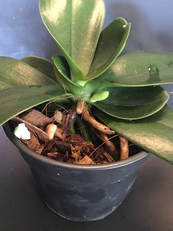
One of the hardest, and most tedious, things to do is watch a bud stem develop. Once you see that bud stem appear, it seems as if the flowers should be opening in a week or two. Sadly, this is not the case. It can actually take 6 to 8 weeks for a bud stem to fully develop and the buds begin to open. I have a new bud stem which has just appeared on my Sedirea japonica. The photo at the right shows the bud spike after 2 weeks of growth from its first appearance. The orchid itself is 3 inches high and 8.5 inches wide. The bud stem was .5 inches long. It took an additional 6 weeks for this bud stem to develop and produce blooms.
The Sedirea genus has an interesting history. The orchids in this genus were originally in the Aerides genus. In 1974, two species in the Aerides genus were segregated out because of certain physiological differences in the column and lip shape. They were moved into the newly created Sedirea genus (Aerides spelled backwards). These two orchids are now called Sedirea japonica and Sedirea subparishii. Sedirea subparishii is native to South China and Sedirea japonica is one of the few species native to Japan, as well Korea and the Ryukyu Islands.
The Sedirea genus has an interesting history. The orchids in this genus were originally in the Aerides genus. In 1974, two species in the Aerides genus were segregated out because of certain physiological differences in the column and lip shape. They were moved into the newly created Sedirea genus (Aerides spelled backwards). These two orchids are now called Sedirea japonica and Sedirea subparishii. Sedirea subparishii is native to South China and Sedirea japonica is one of the few species native to Japan, as well Korea and the Ryukyu Islands.
How Much Sunlight Does My Orchid Need?
This was another excellent question I received at my Junior Flower Show talks. It’s a simple question with a very complicated answer. With over 28,000 different species of orchids that live on every continent in the world except Antarctica, there is no single answer to this question. Even orchids within the same genus require different light levels.
I tell the people who attend my talks and classes that providing the correct light level for your orchid is probably the most important thing you can do. Light is the driver for photosynthesis which provides the carbohydrates for the plant to grow and bloom.
This was another excellent question I received at my Junior Flower Show talks. It’s a simple question with a very complicated answer. With over 28,000 different species of orchids that live on every continent in the world except Antarctica, there is no single answer to this question. Even orchids within the same genus require different light levels.
I tell the people who attend my talks and classes that providing the correct light level for your orchid is probably the most important thing you can do. Light is the driver for photosynthesis which provides the carbohydrates for the plant to grow and bloom.
Without sufficient light, the orchid cannot thrive. It may grow but won’t waste its limited resources on blooming. However, when an orchid gets too much light, it will dissipate the excess light as heat which scorches its leaves. So, too much light will kill the orchid.
If you are preparing to buy new orchids, my suggestion is to ask the grower what light levels he recommends for the specific orchid you are buying. If you are looking for care instructions for orchids you already own, then I have two suggestions. First, look up the light requirements for the genus and use this as a general guideline; and second, let the orchid tell you if it needs more or less light.
Chlorophyll is green in color. If your orchid is getting the right amount of sunlight, the color of its leaves will remain pretty much constant. If your orchid is getting too little light, it will send more chlorophyll into its leaves in an attempt to use all of the available light. This process causes the leaves to become a darker green. Conversely, if your orchid is getting too much light, it will pull chlorophyll from its leaves making them lighter green or even yellow. In extreme cases of too much light, the leaves or pseudobulbs can “sunburn” and turn red or the leaves can develop dried, white patches where it has been scorched.
Scorched Phalaenopsis leaf
What Is a Phalaenopsis Orchid and Where Does it Come From?
I was asked what a Phalaenopsis orchid is and where it comes from. Excellent questions! Phalaenopsis is Greek for “phalaena” meaning moth and “opsis” meaning resembles. These orchids are thought to have gotten their name because they resembled the obsolete genus of large moths called Phalaena. This is why they are known as the “moth orchid”.
There are about 60 species of Phalaenopsis orchids. Most of these orchids are native to the topical* areas of southeastern Asia, China, Taiwan and down into northern Australia. The great majority of Phalaenopsis orchids are also epiphytic (meaning “lives in the air”) plants attached to trees or rocks in the shade under the canopy.
Phalaenopsis orchids have a monopodial (“mono” meaning one and “podial” meaning base) growth habit. This means that they grow upwards on one stem. New leaf growth appears at the top of the stem. The leaves on Phalaenopsis orchids are medium green to light green in color, lobe shaped and often larger and thicker than the leaves of other common genera. This is because monopodial orchids use their leaves, as well as their stem and roots, to store water and nutrients.
As orchids go, Phalaenopsis orchids are very adaptable and accommodating. They can tolerate a wide range of temperatures and humidity. They are shade orchids, so they’re perfect for a home setting. On average, a Phalaenopsis orchid in a 3-inch pot will need to be watered about once per week, depending upon the humidity where it’s growing. See the science lessons attached to the end of the Junior Flower Show tab for a diagram of a Phalaenopsis orchid.
I was asked what a Phalaenopsis orchid is and where it comes from. Excellent questions! Phalaenopsis is Greek for “phalaena” meaning moth and “opsis” meaning resembles. These orchids are thought to have gotten their name because they resembled the obsolete genus of large moths called Phalaena. This is why they are known as the “moth orchid”.
There are about 60 species of Phalaenopsis orchids. Most of these orchids are native to the topical* areas of southeastern Asia, China, Taiwan and down into northern Australia. The great majority of Phalaenopsis orchids are also epiphytic (meaning “lives in the air”) plants attached to trees or rocks in the shade under the canopy.
Phalaenopsis orchids have a monopodial (“mono” meaning one and “podial” meaning base) growth habit. This means that they grow upwards on one stem. New leaf growth appears at the top of the stem. The leaves on Phalaenopsis orchids are medium green to light green in color, lobe shaped and often larger and thicker than the leaves of other common genera. This is because monopodial orchids use their leaves, as well as their stem and roots, to store water and nutrients.
As orchids go, Phalaenopsis orchids are very adaptable and accommodating. They can tolerate a wide range of temperatures and humidity. They are shade orchids, so they’re perfect for a home setting. On average, a Phalaenopsis orchid in a 3-inch pot will need to be watered about once per week, depending upon the humidity where it’s growing. See the science lessons attached to the end of the Junior Flower Show tab for a diagram of a Phalaenopsis orchid.
